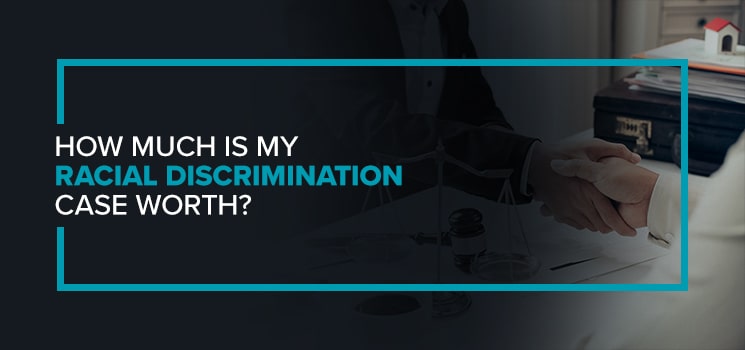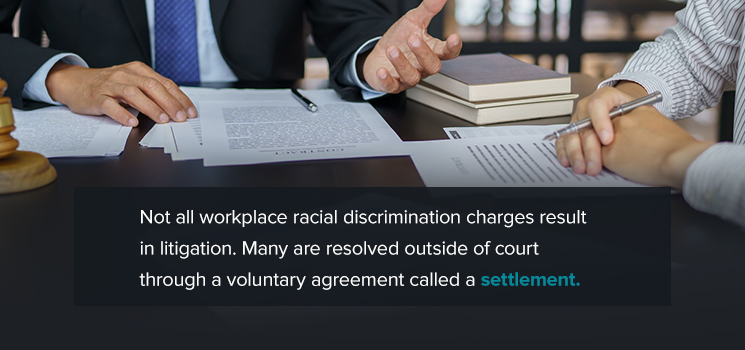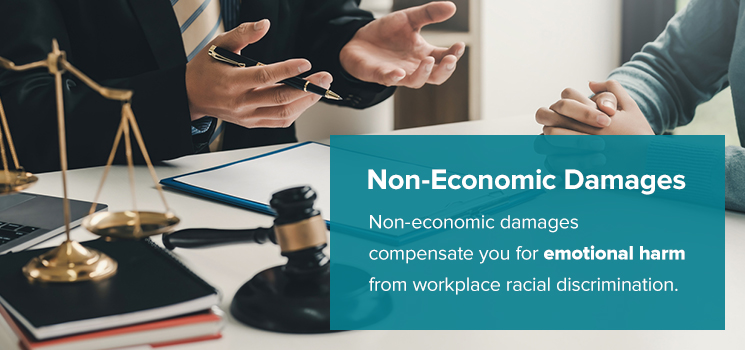Workplace racial discrimination is a serious problem, but several laws guarantee employees’ rights. A victim of racial discrimination can resolve charges through a settlement or lawsuit. These remedies aim to restore the victim to the same position — or a similar one — as they would have been without the discrimination.
If you have experienced racial discrimination at work, you may wonder what litigation could cost. Understanding the possible outcomes of a racial discrimination case can help you and your attorney decide on the most beneficial course of action.
Settlements for Racial Discrimination Cases
Not all workplace racial discrimination charges result in litigation. Many are resolved outside of court through a voluntary agreement called a settlement. In a settlement, the employer pays benefits to the charging party without going through with legal proceedings.
Settlements are common in discrimination cases. The U.S. Equal Employment Opportunity Commission (EEOC) reports that negotiated settlements concluded 6.9% of the over 27,500 race-based workplace discrimination charges filed in 2023. Another 5.9% were withdrawals with benefits, in which the charging party and employer reached an agreement separate from the EEOC that awarded benefits to the charging party. Determining the average amount for racial discrimination settlements is difficult since most settlements are private.
Race discrimination settlements can happen for several reasons. For example, they are a likely outcome in situations where the charging party has a strong case but prefers not to wait out the litigation process before receiving benefits. In these cases, a settlement offers the charging party compensation within a shorter time frame, while the employer may suffer less financial and reputational damage than they would by losing a discrimination case to their employee in court. In such situations, both parties could see a settlement as a win-win. However, the factors are complex, and an experienced discrimination attorney can advise you on whether a settlement really is your best outcome and, if so, help you negotiate a fair amount.
Racial discrimination settlement amounts and benefits vary widely, depending on many factors, including:
- The type of case
- Your location
- The strength of your proof
- Your economic loss, if any
Consulting with an experienced racial discrimination attorney can help you estimate the settlement value you can reasonably expect.
Damages in Racial Discrimination Cases
If you take your case through to litigation and win, the court could award you damages for your expenses and other losses because of the discrimination. A court will award relief depending on the type of discriminatory action and its impact. For example, in a wrongful termination case, the employer may need to offer the charging party the same or a similar position with equal pay and benefits.
Damages for a racial discrimination case are either compensatory or punitive. Compensatory damages include:
- Economic damages such as the out-of-pocket costs of pursuing litigation, searching for a new job or lost wages.
- Non-economic damages such as emotional harm the discrimination caused.
On the other hand, punitive damages punish the employer for malicious or reckless discriminatory acts.
1. Economic Damages
Economic damages repay the charging party for financial losses. These include lost wages and benefits as a result of the discriminatory action. The purpose of awarding economic damages is to restore the income the complainant would have received if not for the discrimination.
Economic damages can include back and front pay. Back pay is compensation to make up the difference between what the employer paid the employee and what they should have paid. Back pay can apply to situations such as failure to hire, removal, suspension and denial of promotion.
Front pay is an element of the “make whole” relief for victims of employment discrimination. This kind of compensation applies when the employer offers reinstatement, but the complainant declines the offer. This could also occur if no similar position is available or the working relationship between the employer and complainant would be hostile. Whereas back pay covers lost income up to the point of the trial, front pay compensates for the expected ongoing consequences of discrimination until you can reach a position with equivalent benefits to those you had before.
Along with compensation for lost wages, economic damages can also include compensation for lost benefits like:
- Bonuses
- Vacation leave
- Health care coverage
- Pension contributions
2. Non-Economic Damages
Non-economic damages compensate you for emotional harm from workplace racial discrimination. This may include:
- Diagnosed mental health conditions like depression or anxiety
- Sleeplessness resulting from mental anguish
- Loss of life enjoyment after the discrimination
- Damage to your reputation
- Strained personal relationships
These damages are especially relevant to racial harassment lawsuits involving offensive, degrading or humiliating treatment on the basis of race.
Non-economic damages are difficult to quantify and require rigorous legal proof to claim successfully. It is not sufficient to say that you were upset or insulted.
It is helpful to keep detailed records or provide compelling testimony from family, coworkers or health care professionals who witnessed the discrimination’s emotional impact on you. These witnesses can attest to the physical and emotional consequences you suffered, like sleeplessness, loss of self-esteem, anxiety or depression.
If applicable, you could also seek counseling or therapy for the emotional distress the discrimination caused you. The charges you accumulate for emotional harm can give a court a clear understanding of what workplace discrimination has cost you. A mental health professional could serve as an expert witness at the discrimination trial.
3. Punitive Damages
The other major category of relief for employment discrimination is punitive damages. These damages are not a result of the harm you suffered. Instead, they are meant to punish your employer’s harmful misconduct.
Courts award punitive damages in about 5% of verdicts. Punitive damages only apply to the defendant if they acted in knowing disregard for the employee’s rights. Demonstrating that an employer acted in this way requires compelling evidence.
When the court awards these damages, the jury decides any amount they feel is fair up to the cap if the state has one, rather than applying a strict formula. In practice, courts also consider the ratio of punitive damages to compensatory damages and may reduce punitive damages if they are far greater. Some states cap the amount that courts can award as punitive damages. There is no cap in Pennsylvania, but federal limits based on the employer’s size apply. In some discrimination cases, such as when the defendant is a government entity, courts cannot award punitive damages.
4. Attorney’s Fees and Costs
The court may also award you attorney’s fees and costs if you win your lawsuit, either in whole or part. Being awarded attorney’s costs help compensate you and your legal team. If you file a charge alleging violations of Title VII of the Civil Rights Act of 1964, you are typically entitled to an award of attorney’s costs if you prevail.
A court calculates attorney’s fees based on the amount of time and money your attorney spent working on your case. The starting point is the “lodestar” value — your attorney’s hourly rate multiplied by the hours they spent on your case. From there, the court can adjust the amount of attorney’s fees to award based on other factors like the case’s complexity and the resources your attorney invested. You may also be eligible for an award of attorney’s fees if you resolve the case through a negotiated settlement out of court. In addition, a prevailing complainant is also entitled to the recovery of costs like transcription costs and witness fees.
What Is My Racial Discrimination Case Worth?
When an attorney recommends that a charging party either make a settlement or continue to litigation, they consider many elements likely to impact the case’s outcome. When advising you whether to accept or reject a settlement offer, lawyers will look at these factors:
- Your evidence’s strength compared to the risk of losing litigation.
- How grievous your employer’s discrimination was, and how likely it is to anger a jury.
- Whether your employer has a history of racial discrimination.
- The extent of economic and non-economic damages you suffered.
- Whether your employer has insurance to cover your claims.
- Your willingness to wait through the time-consuming process of pursuing litigation.
Determining whether you should pursue litigation or a settlement takes time and effort. An experienced lawyer will analyze all of these factors and recommend the course of action they think will benefit you most.
To decide if you should sue your employer over racial discrimination, consider the potential costs and the outcome you are hoping for. Litigation is one of the best systems in American law for creating accountability for unjust actions. If your employer discriminated against you, pursuing a lawsuit can help keep similar incidents from occurring again. A racial discrimination lawsuit can also help you recover from lost wages and emotional damage because of discriminatory action.
Contact Weisberg Cummings for Racial Discrimination Attorneys in Pennsylvania
Many factors go into the decision to pursue litigation for racial discrimination. If you believe you may have a case and want to pursue it so you can recover your losses, the attorneys at Weisberg Cummings are here to help. We can determine which evidence is most relevant to your case. Our experienced attorneys can argue for you in court or help you reach a beneficial settlement with your employer.
Contact us today and get your free consultation with one of our trusted lawyers.




